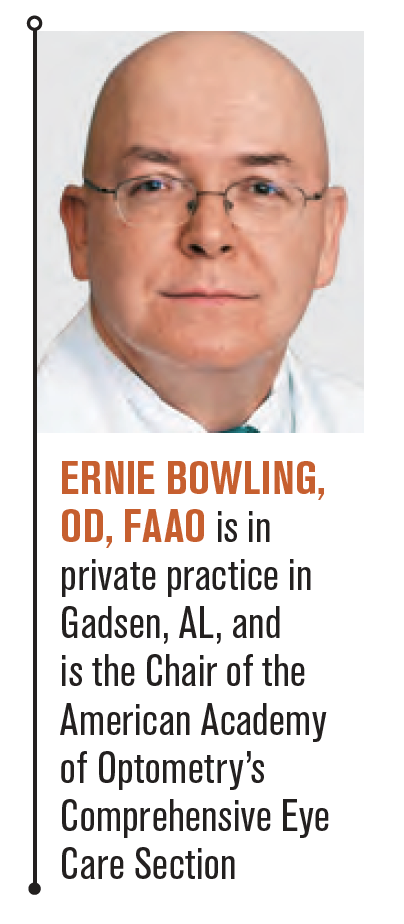Coronavirus: A quick summary for optometrists
Every practicing optometrist needs to understand the risks inherent with coronavirus to be better informed and readily able to care for patients.


The coronavirus outbreak is all over the news. Media coverage is saturated, the stock market is plunging from the potential worldwide economic fallout, and with all this continual information there is concern among healthcare providers and their patients.
What should optometrists know about the coronavirus, and how should they care for their patients and protect themselves if the virus reaches their doors? Every practicing optometrist needs to understand the risks inherent with this outbreak to be better informed and readily able to care for patients.
Related: COVID-19 and contact lens wear: What ODs and patients need to know
History of the outbreak
Dec. 31, 2019: China alerted the World Health Organization (WHO) of a pneumonia outbreak of unknown cause in the city of Wuhan in Hubei province.1 The seafood and animal market thought to be the virus’ source was closed the next day.2 The causative organism was identified as a novel coronavirus (named 2019-nCOV).
Coronaviruses are a large family of viruses producing illnesses ranging from the common cold to more severe diseases. Coronaviruses are zoonotic, which means they are transmitted between animals and humans. A novel coronavirus (nCoV) is a new strain that has not been previously identified in humans. Jan. 30: The WHO declared 2019-nCOV to be a global health emergency, acknowledging the disease represented a risk beyond the borders of China.3
Feb. 11: The WHO renamed the virus COVID-19.
Feb. 23: The U.S. Centers for Disease Control and Prevention (CDC) reported the potential public health threat posed by COVID-19 to be high, both globally and in the United States.4
March 1: The WHO reported more than 87,137 confirmed cases in 59 countries, and 2977 people have died from COVID-19.5 Greater than 1,700 healthcare professionals have been infected with the virus, causing six deaths, including one ophthalmologist.6-8
March 3: The CDC reported 60 confirmed cases in the United States, with six total deaths and 12 states reporting cases.9 This includes both confirmed and presumptive positive cases reported to CDC. It does not include people who returned to the U.S. via State Department-chartered flights. Twenty-two of the 60 cases are travel associated, 11 are likely person-to-person transmission, and 27 are under investigation, which means that state and local public health officials are still investigating how these people were infected.
Related: Optometry during COVID-19 pandemic
CDC reporting
The CDC is no longer reporting the number of patients under investigation for COVID-19 or patients who have tested negative for the virus.
“With more and more testing done at states, these numbers would not be representative of the testing being done nationally,” said Nancy Messonnier, MD, director of the Center for the National Center for Immunization and Respiratory Diseases (NCIRD) at the CDC.
Health officials in Washington state reported Saturday that a man in his 50s with underlying health conditions died at a hospital in Kirkland after testing positive for COVID-19, the first reported fatality from the virus in the U.S.10
Related: One OD weighs in during office closure
Transmission and systemic manifestations
There is growing evidence the COVID-19 virus is transmitted human-to-human among close contacts.8 The route of transmission of COVID-19 is not yet fully known, but it is thought to be mainly respiratory.11
Comparisons are being made to severe acute respiratory syndrome (SARS) and Middle East respiratory syndrome (MERS), as both were caused by a coronavirus. SARS emerged in 2003 and caused the first pandemic of the 21st century, infecting more than 8000 people and killing 774 in 26 countries.12 MERS coronavirus was isolated in 201213 with over 2,400 reported cases and over 850 deaths.14
The CDC currently believes symptoms of COVID-19 may appear in as few as two days or as long as two weeks, with median estimates of five to six days post exposure based on what has been previously seen as the incubation period of the MERS virus. Symptom onset include fever, cough, fatigue, and shortness of breath.15 Sore throat has also been reported in some patients early in the clinical course of the disease. Less commonly reported symptoms include nausea, diarrhea, headache, and sputum production with or without blood.16
In more severe cases, COVID-19 infection can cause pneumonia, SARS, kidney failure, and death.17
Related: How ODs are addressing COVID-19 in their practices
Possible early ocular signs
Evidence shows that some coronavirus infections can occasionally cause conjunctivitis in humans. In fact, in 2004 another coronavirus, NL-63, was first identified in a baby with bronchiolitis and conjunctivitis.18
In 28 cases subsequently confirmed in French children with coronavirus NL-63, 17 percent had conjunctivitis.19 Although in the initial clinical reports of 150 patients with COVID-19 conjunctivitis has not been observed clinically, it cannot be excluded because it is known a coronavirus has been recognized to cause conjunctivitis.18
As of Feb. 10, information emerged identifying the conjunctiva as an alleged route of exposure. COVID-19 may enter the body through the eyes and spread via the superficial conjunctival blood vessels to the entire body.16 As these patients may present with a viral conjunctivitis, it is important for eyecare professionals to inquire about travel history, family history, and systemic flu-like symptoms.
COVID-19 may cause other ocular signs and symptoms, including photophobia, irritation, conjunctival injection, and a watery discharge. These signs are predominantly self-limiting but may require supportive care. Ocular tears and discharge are a potential contamination source, and the eye is likewise a route of exposure.16
Precautions to take
Standard recommendations from the WHO to prevent infection spread include regular hand washing with soap and water or alcohol-based disinfectants, covering the mouth and nose with a bent elbow or tissue when coughing or sneezing, and thoroughly cooking meat and eggs. Maintain at least a three-foot distance between yourself and anyone showing signs of a respiratory illness such as coughing or sneezing.5
Avoid touching the eyes, nose, and mouth as hands can transfer the virus to these areas.
The WHO and CDC provide guidance on personal protective equipment in infection prevention and control when COVID-19 is suspected. Eye protection (goggles) and facial protection (face mask) should be worn, and healthcare workers are advised against touching mucosal membranes (eyes, nose, or mouth) in at-risk locations, in particular for healthcare workers in hospital environments.20
The FDA and the CDC in a joint effort on Monday took action to make more respirators, including certain N95s, available to health care personnel. The action allows approved respirators not currently regulated by the FDA to be used in a health care setting by health care personnel during the coronavirus (COVID-19) outbreak.21
The FDA has fast-tracked development of laboratory testing for COVID-19 in order to achieve more rapid testing capacity in the United States.22 U.S. researchers at the University of Nebraska Medical Center in Omaha are conducting a clinical trial of a treatment for COVID-19.23 Two trials of the same drug, an experimental antiviral called remdesivir, have been up and running in China for a few weeks.24 In a best-case scenario, it is even possible vaccines may be available in not much more than a year.25
Conclusion
During this time of limited but rapidly expanding information, eyecare providers need to stay highly vigilant to recognize early manifestation of COVID-19, including the consideration of viral conjunctivitis as a possible early presentation of the disease. Watching 24-hour news coverage of the situation can cause a twinge of fear.
Yet society is not on the brink of doom. Taking modest and sensible precautions should keep most people safe. Still, all healthcare personnel, including optometrists, should be aware of the disease and on the lookout.
References:
1. World Health Organization. Pneumonia of unknown cause – China. Available at: https://www.who.int/csr/don/05-january-2020-pneumonia-of-unkown-cause-china/en/. Accessed 3/3/20.
2. Huang C , Wang Y , Li X, et al. Clinical features of patients infected with 2019 novel coronavirus in Wuhan, China. Lancet. 2020 Feb 15;395(10223):497-506.
3. World Health Organization. Statement on the second meeting of the International Health Regulations (2005) Emergency Committee regarding the outbreak of novel coronavirus (2019-nCoV). Available at: https://www.who.int/news-room/detail/30-01-2020-statement-on-the-second-meeting-of-the-international-health-regulations-(2005)-emergency-committee-regarding-the-outbreak-of-novel-coronavirus-(2019-ncov). Accessed 3/3/20.
4. Centers for Disease Control and Prevention. Coronavirus Disease 2019 (COVID-19) Situation Summary. Available at: https://www.cdc.gov/coronavirus/2019-ncov/summary.html. Accessed 3/3/20.
5. World Health Organization. Coronavirus disease (COVID-19) outbreak.
Available at: https://www.who.int/emergencies/diseases/novel-coronavirus-2019. Accessed 3/3/20.
6. Imai N , Dorigatti I , Cori A , et al. Report 2: estimating the potential total number of novel coronavirus cases in Wuhan City, China. Imperial College London. Available at: https://www.imperial.ac.uk/media/imperial-college/medicine/sph/ide/gida-fellowships/2019-nCoV-outbreak-report-17-01-2020.pdf. Accessed 3/4/20.
7. Chan JF, Yuan S , Kok KH , et al. A familial cluster of pneumonia associated with the 2019 novel coronavirus indicating person-to-person transmission: a study of a family cluster. Lancet .2020 Feb 15;395(10223):514-523
8. Li Q , Guan X , Wu P, et al. Early transmission dynamics in Wuhan, China, of novel Coronavirus–Infected pneumonia. N Engl J Med. 2020. doi:10.1056/NEJMoa2001316.
9. Centers for Disease Control and Prevention. Coronavirus Disease 2019 (COVID-19) in the U.S. Available at: https://www.cdc.gov/coronavirus/2019-nCOV/cases-in-us.html. Accessed 3/3/20.
10. Centers for Disease Control and Prevention Transcript for the CDC Telebriefing Update on COVID-19. Available at: https://www.cdc.gov/media/releases/2020/t0303-COVID-19-update.html. Accessed 3/4/20.
11. Bellware K, Achenbach J, Mettler K, et al. Coronavirus live updates. Wash Post. Available at: https://www.washingtonpost.com/world/2020/03/01/coronavirus-live-updates/. Accessed 3/5/20.
12. World Health Organization. Laboratory testing for 2019 novel coronavirus (2019-nCoV) in suspected human cases - Interim guidance. Available at: https://www.who.int/publications-detail/laboratory-testing-for-2019-novel-coronavirus-in-suspected-human-cases-20200117. Accessed 3/4/20.
13. Peiris JSM, Yuen KY, Osterhaus AD, Stöhr K. The severe acute respiratory syndrome. N Engl J Med. 2003 Dec 18;349(25):2431-41.
14. Zaki AM, van Boheemen S , Bestebroer TM , et al. Isolation of a novel coronavirus from a man with pneumonia in Saudi Arabia. N Engl J Med. 2012 Nov 8;367(19):1814-20.
15. Killerby ME , Biggs HM , Midgley CM , et al. Middle East respiratory syndrome coronavirus transmission. Emerg Infect Dis. 2020 Feb;26(2):191-198.
16. Centers for Disease Control and Prevention. About Coronavirus Disease 2019 (COVID-19). Available at: https://www.cdc.gov/coronavirus/2019-ncov/about/index.html. Accessed 3/4/20.
17. American Optometric Association. Health Policy Institute. Statement: Doctors of Optometry and COVID-19. Available at: https://www.aoa.org/documents/HPI/HPI%20CoronaVirus%20Statement%201-30-20.pdf. Accessed 3/4/20.
18. World Health Organization. Available at: https://www.who.int/health-topics/coronavirus. Accessed 3/4/20.
19. van der Hoek L , Pyrc K , Jebbink MF , et al. Identification of a new human coronavirus. Nat Med. 2004 Apr;10(4):368-73.
20. Vabret A, Mourez , Dina J, et al. Human coronavirus NL63, France. Emerg Infect Dis. 2005 Aug;11(8):1225-9.
21. Li JO, Lam DSC, Chen Y, Ting DSW. Novel Coronavirus disease 2019 (COVID-19): The importance of recognizing possible early ocular manifestation and using protective eyewear. Br J Ophthalmol. 2020 Mar;104(3):297-298.
22. US. Food & Drug Administration. Coronavirus (COVID-19) Update: FDA and CDC take action to increase access to respirators, including N95s, for health care personnel. Available at: http://s2027422842.t.en25.com/e/es?s=2027422842&e=307673&elqTrackId=376c7bc788024cd5a73d955f2e3dcbdc&elq=3955d149e77f4750be0fa15e59c1d731&elqaid=11459&elqat=1. Accessed 3/4/20.
23. US. Food & Drug Administration. Coronavirus (COVID-19) update: FDA issues new policy to help expedite availability of diagnostics. Available at: https://www.fda.gov/news-events/press-announcements/coronavirus-covid-19-update-fda-issues-new-policy-help-expedite-availability-diagnostics. Accessed 3/4/20.
24. National Institutes of Health. NIH clinical trial of remdesivir to treat COVID-19 begins.
Available at: https://www.nih.gov/news-events/news-releases/nih-clinical-trial-remdesivir-treat-covid-19-begins. Accessed 3/4/20.
25. Westman N. An experimental treatment for the new coronavirus is being tested in the US. The Verge. Available at: https://www.theverge.com/2020/2/26/21154220/coronavirus-experimental-treatment-remdesivir-trials-us-china-ebola. Accessed 3/4/20.
26. Fickling D. What the coronavirus end game will look like. Yahoo! Finance. Available at: https://finance.yahoo.com/news/coronavirus-end-game-look-000023845.html. Accessed 3/4/20.
Newsletter
Want more insights like this? Subscribe to Optometry Times and get clinical pearls and practice tips delivered straight to your inbox.
2 Commerce Drive
Cranbury, NJ 08512
All rights reserved.